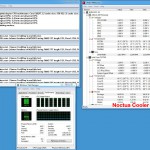One of the hottest topics of debate among KitGuru readers is the correct approach to installing a CPU cooler
We took a test system consisting of a 3.9GHz Core i7-4770K CPU (stock clock speed), an ASRock Z87 Extreme4 motherboard, Sapphire R9 290 Trix graphics card, Samsung 840 EVO SSD and Seasonic Platinum Fanless 520W power supply. Within the ASRock set-up screen we set HW Monitor to ‘Performance'.
Our chosen chassis was the Phanteks Enthoo Pro with both case fans disconnected. This means the only active fan was the CPU cooler as we can pretty much discount the Sapphire graphics card. At idle the Sapphire draws a trivial amount of power and is cool to the touch.
Our chosen CPU coolers were a stock Intel cooler, £30 Arctic Cooling Freezer i30 and a £49 Noctua NH-U12S. The two tower coolers are similar in layout and each use a 120mm fan and heatpipes, however they differ in detail and in particular in terms of the mounting method. We detail this in the video above.
We loaded the Cpu to 100 percent with Prime 95 which is a severe test for any cooling system and pushes the hardware to the absolute limit.
As you'll see in the video the two tower cooler outperform the Intel cooler by a significant margin.



Intel cooler idles at 38 degrees, loaded at 100 degrees, Delta 62 degrees
Noctua NH-U12S idle 25 degrees, loaded 65 degrees, Delta 40 degrees
Arctic Cooling Freezer i30 idle 26 degrees, loaded 70 degrees, Delta 44 degrees
Discuss on our Facebook page, over HERE.
Kitguru says: You will have to watch the video to find our views on the application of thermal compound so be sure to post your comments to let us know what you think.
 KitGuru KitGuru.net – Tech News | Hardware News | Hardware Reviews | IOS | Mobile | Gaming | Graphics Cards
KitGuru KitGuru.net – Tech News | Hardware News | Hardware Reviews | IOS | Mobile | Gaming | Graphics Cards



Can’t believe you made a video about air coolers and didn’t use a 212 Evo
Your max temperature on the noctua was 68 degrees… not 65 as you said.
I use the pea sized method, but I’m much more meticulous than you. This is probably because you were in a rush on the video, but still. In my experience, any ‘smoothing’ method (with a credit card etc) results in slightly higher temps, because you’ve spread in foreign matter and air. The pea sized/line method both spread just fine and don’t have that problem. I would say though that doing what you did when the little rubber guide fell over, taking off the spread paste and just putting it back on – that results in worse temps for the same reason as above, you’ve folded in air…
I have a 212 Evo, my brother has a 212 Evo, my uncle has a 212 Evo, and my cousin has a 212 Plus. I should be outraged.
Any chance you could check these numbers again vs. a de-lidded CPU? I’ve found my temps have dropped greatly, but people still seem to think it won’t make too much difference.